Under the Whyte notation for the classification of steam locomotives, 2-10-2 represents the wheel arrangement of two leading wheels, ten powered and coupled driving wheels, and two trailing wheels. In the United States of America and elsewhere the 2-10-2 is known as the Santa Fe type, after the Atchison, Topeka and Santa Fe Railway that first used the type in 1903.

The British Railways Standard Class 9F 2-10-0 is a class of steam locomotive designed for British Railways by Robert Riddles. The Class 9F was the last in a series of standardised locomotive classes designed for British Railways during the 1950s, and was intended for use on fast, heavy freight trains over long distances. It was one of the most powerful steam locomotive types ever built for British Railways, and successfully performed its intended duties. The class was given the nickname of 'Spaceships', due to its size and shape.

The London and North Eastern Railway (LNER) Class V2 2-6-2 steam locomotives were designed by Sir Nigel Gresley for express mixed traffic work, and built at the LNER shops at Doncaster and Darlington between 1936 and 1944. The best known is the first of the class, 4771 Green Arrow, which is the sole survivor of the class.
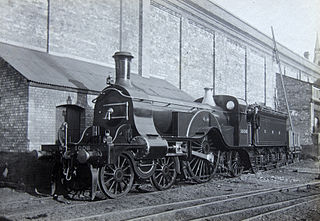
The Great Northern Railway (GNR) No. 1 class Stirling Single is a class of steam locomotive designed for express passenger work. Designed by Patrick Stirling, they are characterised by a single pair of large driving wheels which led to the nickname "eight-footer". Originally the locomotive was designed to haul up to 26 passenger carriages at an average speed of 47 miles per hour (76 km/h)." They could reach speeds of up to 85 mph.

The Great Western Railway (GWR) 4300 Class is a class of 2-6-0 (mogul) steam locomotives, designed by G.J. Churchward for mixed traffic duties. 342 were built from 1911–1932.
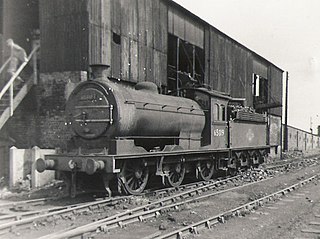
The North Eastern Railway (NER) Class P3, classified J27 by the LNER, is a class of 0-6-0 steam locomotive. The P3 Class was designed by Wilson Worsdell and was a relatively minor modification of the existing North Eastern Railway Class P2. The most significant change was a deeper firebox with shallower sloping fire grate. This was achieved by raising the boiler slightly, and by reducing the clearance between the firebox and the rear axle. The P3 Class were a freight engine by nature and used for hauling long trains of freight.

The Great Northern Railway Class H4 was a class of 2-6-0 steam locomotive designed for mixed-traffic work.
The Midland Railway 1000 Class is a class of 4-4-0 steam locomotive designed for passenger work. They were known to reach speeds of up to 85 mph.
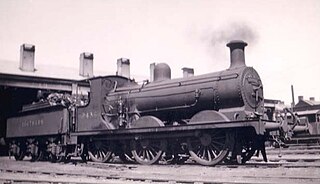
The London, Brighton and South Coast Railway C2 class was a class of 0-6-0 steam locomotives, intended for heavy freight trains. Fifty-five were built by the Vulcan Foundry between 1893 and 1902 to the design of Robert J. Billinton. Forty-five of these were later rebuilt between 1908 and 1940, with a larger boiler as the C2X class.
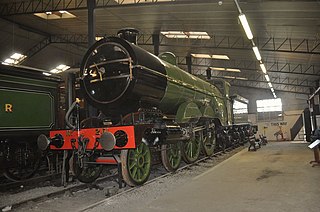
The Great Northern Railway (GNR) Class C1 is a type of 4-4-2 steam locomotive. One, ex GNR 251, later LNER 2800, survives in preservation. Much like their small boiler cousins, they were capable of reaching speeds of up to 90 mph (145 km/h). They were also known as Large Atlantics.

The North Eastern Railway (NER) Class E, classified as Class J71 by the London and North Eastern Railway (LNER), was a class of small 0-6-0T steam locomotive designed by T.W. Worsdell. They had inside cylinders and Stephenson valve gear and were the basis for the later NER Class E1.
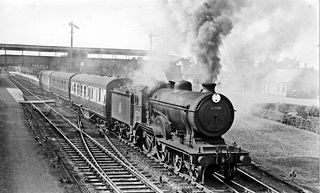
The GER Classes S46, D56 and H88 were three classes of similar 4-4-0 steam locomotive designed by James Holden and A. J. Hill (H88) for the Great Eastern Railway.

The NER 901 Class was a class of 2-4-0 steam locomotive of the North Eastern Railway, designed by Edward Fletcher. Between 1872 and 1882 55 of the class were built for the NER.
The Taff Vale Railway U and U1 classes were 0-6-2T steam tank locomotive operated by Taff Vale Railway, Wales, from 1895. All were still in use when the Taff Vale Railway was acquired by the Great Western Railway in 1922, but were withdrawn from traffic between 1927 and 1931.
The North Eastern Railway Class S2 - London and North Eastern Railway Class B15 - was a mixed-traffic 4-6-0 steam locomotive designed by Vincent Raven. The design was based on NER Class S.
The Midland Railway Johnson 0-6-0 were a class of locomotives serving Britain's Midland Railway system in the late 19th and early 20th centuries. Between 1875 and 1908 the Midland Railway, under the control of locomotive superintendents Samuel Waite Johnson and Richard Deeley, ordered 935 goods tender engines of 0-6-0 type, both from the railway's own shops at Derby and various external suppliers. Although there were many variations between different batches both as delivered and as successively rebuilt, all 935 can be regarded as a single series, one of the largest classes of engine on Britain's railways. The locomotives served as late as 1964, but none of them now survive.
The NER Class P1 was a class of 0-6-0 steam locomotives of the North Eastern Railway. Class P1 was a development of Class P, having a boiler four inches longer, and a firebox six inches longer. To accommodate these, the wheelbase was increased by nine inches. The cylinder stroke was also increased by two inches. None survived into preservation
The GWR 56 Class were 2-4-0 tender locomotives designed for the Great Western Railway by Joseph Armstrong and built at Swindon Works between 1871 and 1872.
The 1661 Class was William Dean's second design of tank locomotive for England's Great Western Railway. Like the 1813 Class which preceded them, there were 40 1661s, turned out of Swindon Works in two batches.

The A class of the Swedish State Railways (SJ) was a type of steam locomotive built in 1906–1909 for hauling mainline express trains. The 26 locomotives were built to replace older types that could not cope with the increasingly heavy express trains, but soon became insufficient themselves. They were relegated to less important passenger trains, and five were transferred to then-independent Ostkustbanan (OKB) in the 1920s, but returned when that company was nationalized in 1933.












